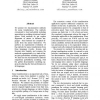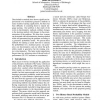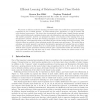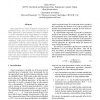97
Voted
PAMI
2006
15 years 23 days ago
2006
Linear subspace methods that provide sufficient reconstruction of the data, such as PCA, offer an efficient way of dealing with missing pixels, outliers, and occlusions that often ...
106
Voted
EMNLP
2006
15 years 2 months ago
2006
We present two discriminative methods for name transliteration. The methods correspond to local and global modeling approaches in modeling structured output spaces. Both methods d...
112
Voted
ACL
2004
15 years 2 months ago
2004
Discriminative methods have shown significant improvements over traditional generative methods in many machine learning applications, but there has been difficulty in extending th...
105
Voted
NIPS
2007
15 years 2 months ago
2007
We demonstrate that log-linear grammars with latent variables can be practically trained using discriminative methods. Central to efficient discriminative training is a hierarchi...
111
click to vote
CLOR
2006
15 years 4 months ago
2006
Many approaches to object recognition are founded on probability theory, and can be broadly characterized as either generative or discriminative according to whether or not the dis...
111
Voted
ECCV
2008
Springer
16 years 2 months ago
2008
Springer
Appearance features are good at discriminating activities in a fixed view, but behave poorly when aspect is changed. We describe a method to build features that are highly stable u...
112
click to vote
ICCV
2005
IEEE
16 years 2 months ago
2005
IEEE
We present an efficient method for learning part-based object class models from unsegmented images represented as sets of salient features. A model includes parts' appearance...
124
Voted
CVPR
2006
IEEE
16 years 2 months ago
2006
IEEE
Flat appearance-based systems, which combine clever image representations with standard classifiers, might be the most effective way to recognize objects using current technologie...
105
Voted
CVPR
2005
IEEE
16 years 2 months ago
2005
IEEE
Many approaches to object recognition are founded on probability theory, and can be broadly characterized as either generative or discriminative according to whether or not the di...




